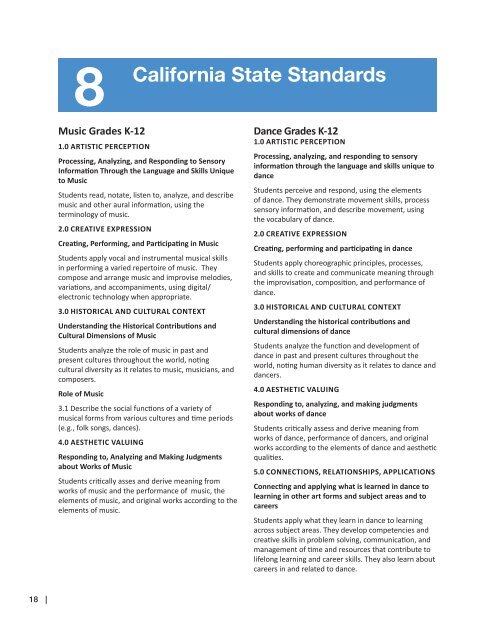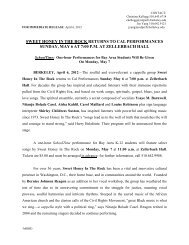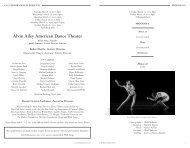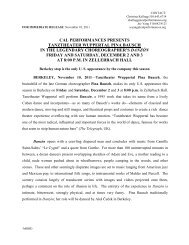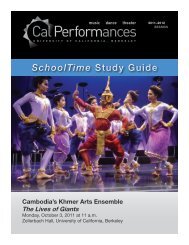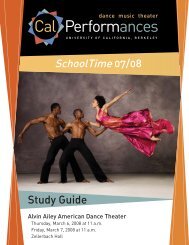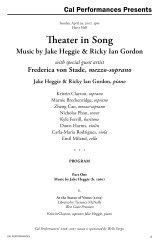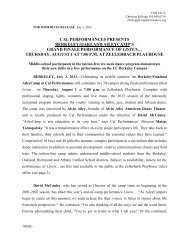SchoolTime Study Guide - Cal Performances - University of ...
SchoolTime Study Guide - Cal Performances - University of ...
SchoolTime Study Guide - Cal Performances - University of ...
- No tags were found...
You also want an ePaper? Increase the reach of your titles
YUMPU automatically turns print PDFs into web optimized ePapers that Google loves.
8<strong>Cal</strong>ifornia State StandardsMusic Grades K-121.0 Artistic PerceptionProcessing, Analyzing, and Responding to SensoryInformation Through the Language and Skills Uniqueto MusicStudents read, notate, listen to, analyze, and describemusic and other aural information, using theterminology <strong>of</strong> music.2.0 Creative ExpressionCreating, Performing, and Participating in MusicStudents apply vocal and instrumental musical skillsin performing a varied repertoire <strong>of</strong> music. Theycompose and arrange music and improvise melodies,variations, and accompaniments, using digital/electronic technology when appropriate.3.0 Historical and Cultural ContextUnderstanding the Historical Contributions andCultural Dimensions <strong>of</strong> MusicStudents analyze the role <strong>of</strong> music in past andpresent cultures throughout the world, notingcultural diversity as it relates to music, musicians, andcomposers.Role <strong>of</strong> Music3.1 Describe the social functions <strong>of</strong> a variety <strong>of</strong>musical forms from various cultures and time periods(e.g., folk songs, dances).4.0 Aesthetic ValuingResponding to, Analyzing and Making Judgmentsabout Works <strong>of</strong> MusicStudents critically asses and derive meaning fromworks <strong>of</strong> music and the performance <strong>of</strong> music, theelements <strong>of</strong> music, and original works according to theelements <strong>of</strong> music.Dance Grades K-121.0 Artistic PerceptionProcessing, analyzing, and responding to sensoryinformation through the language and skills unique todanceStudents perceive and respond, using the elements<strong>of</strong> dance. They demonstrate movement skills, processsensory information, and describe movement, usingthe vocabulary <strong>of</strong> dance.2.0 Creative ExpressionCreating, performing and participating in danceStudents apply choreographic principles, processes,and skills to create and communicate meaning throughthe improvisation, composition, and performance <strong>of</strong>dance.3.0 Historical and Cultural ContextUnderstanding the historical contributions andcultural dimensions <strong>of</strong> danceStudents analyze the function and development <strong>of</strong>dance in past and present cultures throughout theworld, noting human diversity as it relates to dance anddancers.4.0 Aesthetic ValuingResponding to, analyzing, and making judgmentsabout works <strong>of</strong> danceStudents critically assess and derive meaning fromworks <strong>of</strong> dance, performance <strong>of</strong> dancers, and originalworks according to the elements <strong>of</strong> dance and aestheticqualities.5.0 Connections, Relationships, ApplicationsConnecting and applying what is learned in dance tolearning in other art forms and subject areas and tocareersStudents apply what they learn in dance to learningacross subject areas. They develop competencies andcreative skills in problem solving, communication, andmanagement <strong>of</strong> time and resources that contribute tolifelong learning and career skills. They also learn aboutcareers in and related to dance.18 |


